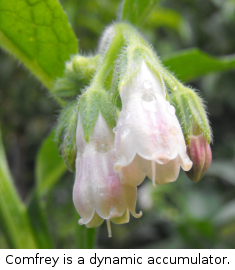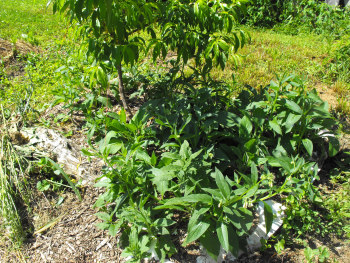
Adding micronutrients to the soil
 The big chemical
companies are now considering adding micronutrients into their chemical
fertilizer mixes along with nitrogen, potassium, and phosphorus.
As usual, I don't think that's the best option.
Instead, I like the idea of building up the soil by adding naturally
occurring micronutrients through compost, manure, and mulch.
The big chemical
companies are now considering adding micronutrients into their chemical
fertilizer mixes along with nitrogen, potassium, and phosphorus.
As usual, I don't think that's the best option.
Instead, I like the idea of building up the soil by adding naturally
occurring micronutrients through compost, manure, and mulch.
A related option, favored by permaculturalists, is to use dynamic
accumulators to add micronutrients back
into their topsoil. These plants are able to latch onto
micronutrients
in the soil, either by sending roots deep into the subsoil where the
micronutrients are plentiful, or by simply having a greater affinity to
micronutrients. Either way, the dynamic accumulators end up with
high
levels of certain micronutrients in their leaves. We can cut
these
leaves off and use them as mulch or compost around micronutrient
deficient plants, refreshing the micronutrient content of the soil.

Comfrey is everyone's
favorite dynamic accumulator since it
concentrates silicon, nitrogen, magnesium, calcium, potassium, and
iron. In my young forest garden, I've planted comfrey around my
nectarine tree. As the comfrey gets to be a foot tall or so, I
whack
it all down and let it rot back into the soil, feeding my tree.
| This post is part of our Micronutrient lunchtime series.
Read all of the entries: |
Want more in-depth information? Browse through our books.
Or explore more posts by date or by subject.
About us: Anna Hess and Mark Hamilton spent over a decade living self-sufficiently in the mountains of Virginia before moving north to start over from scratch in the foothills of Ohio. They've experimented with permaculture, no-till gardening, trailersteading, home-based microbusinesses and much more, writing about their adventures in both blogs and books.
Want to be notified when new comments are posted on this page? Click on the RSS button after you add a comment to subscribe to the comment feed, or simply check the box beside "email replies to me" while writing your comment.

I remember you talking about alfalfa like that years ago. It's nice to have so many options out there as dynamic accumulators, though, especially perennials!
I don't think I'm ready to commit to a kudzu battle in my own yard, but I've often wondered if there's an effective way to harvest the stuff growing along the side of the road. If gardeners figured out that they could easily harvest that source of plant micronutrients, I'll bet we'd get our infestation under control lickety split! Maybe I need to set Mark on inventing some kind of gadget for the harvest....